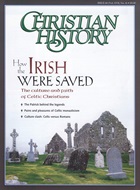Millions worldwide have found in the humble prayer text and lyric tune "Be Thou My Vision" a vehicle for praise and worship. It offers a singular voice of fierce devotion rooted in medieval Celtic Christianity that is still relevant today.
The eighth-century prayer was composed in Old Irish:
Rob tu mo bhoile,
a Comdi cride.
Ni ni nech aile,
acht ri secht nime …
Only in this century did this text find its English translation. Mary Byrne rendered it into literal English prose in 1905:
Be thou my vision,
O Lord of my heart.
None other is aught
but the King of the seven heavens.
Be thou my meditation
by day and night;
May it be thou that I behold
even in my sleep.
Be thou my speech,
be thou my understanding,
Be thou with me,
be I with thee.
Be thou my father,
be I thy son.
Mayst thou be mine,
may I be thine.
Be thou my battle-shield,
be thou my sword.
Be thou my dignity,
be thou my delight.
Be thou my shelter,
be thou my stronghold.
Mayst thou raise me up
to the company of the angels.
Be thou every good
to my body and soul.
Be thou my kingdom
in heaven and on earth.
Be thou solely
chief love of my heart.
Let there be none other,
O high King of Heaven.
Till I am able
to pass into thy hands,
My treasure, my beloved,
through the greatness of thy love.
Be thou alone
my noble and wondrous estate.
I seek not men,
nor lifeless wealth.
Be thou the constant guardian
of every possession and every life.
For our corrupt desires are dead
at the mere sight of thee.
Thy love in my soul
and in my heart—
Grant this to me,
O King of the seven heavens.
O King of the seven heavens
grant me this—
Thy love to be in my heart
and in my soul.
With the King of all, with him
after victory won by piety
May I be in the kingdom of heaven
O brightness of the son.
Beloved Father,
hear, hear my lamentations;
Timely is the cry of woe
of this miserable wretch.
O heart of my heart,
whate'er befall me,
O ruler of all,
be thou my vision.
It remained for Eleanor M. Hull, in her 1912 Poem Book of the Gael to offer a metrical, poetic version of Byrne's work in twelve rhymed couplets that have been used by editors since to arrive at versions of the four-stanza hymn so widely treasured today.
Concurrently, Patrick W. Joyce was publishing the traditional tune SLANE (named for a hill near Tara where St. Patrick challenged druid priests in lighting the paschal fire). Thus paired with the English text, the "Be Thou My Vision" sung today first appeared in the Irish Church Hymnal in 1919.
James D. Smith III is pastor of Clairemont Emmanuel Baptist Church in San Diego, and an editorial adviser for Christian History.
Copyright © 1998 by the author or Christianity Today/Christian History magazine.
Click here for reprint information on Christian History.

Support Our Work
Subscribe to CT for less than $4.25/month






























